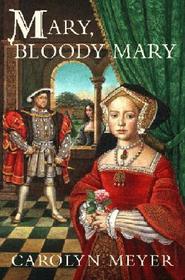Helpful Score: 2
From Publishers Weekly
This riveting slice of fictional royal history paints a sympathetic portrait of Henry VIII's oldest daughter, before she earns the title Bloody Mary. Trained not to weep in public, the young princess puts on a steely front but lives in constant fear of her father's tyranny. The novel begins in 1527 when 11-year-old Mary learns that she has been betrothed to the middle-aged king of France. The accessible first-person narrative chronicles Mary's dramatic change in status from riches to rags when her father attempts to annul his marriage to Catherine, Mary's mother, and conveys how Mary's (and the nation's) fate is affected by her father's obsession with "bewitching" Anne Boleyn, his excessive spending and his execution sprees. The novel ends in 1536, just after Henry VIII takes his third wife, Jane Seymour, and things begin to look a bit more optimistic for Mary. While the pacing is at times uneven, Meyer's (Gideon's People) account convincingly sets the stage for Mary's own sprees of persecution (mentioned in a thorough afterword) and provides an excellent introduction to pre-Renaissance customs, fashions and morals. The author's characterization of the Catholic queen demonstrates there was much more to Mary than the deeds that earned her a sanguinary nickname. Ages 11-up.
This riveting slice of fictional royal history paints a sympathetic portrait of Henry VIII's oldest daughter, before she earns the title Bloody Mary. Trained not to weep in public, the young princess puts on a steely front but lives in constant fear of her father's tyranny. The novel begins in 1527 when 11-year-old Mary learns that she has been betrothed to the middle-aged king of France. The accessible first-person narrative chronicles Mary's dramatic change in status from riches to rags when her father attempts to annul his marriage to Catherine, Mary's mother, and conveys how Mary's (and the nation's) fate is affected by her father's obsession with "bewitching" Anne Boleyn, his excessive spending and his execution sprees. The novel ends in 1536, just after Henry VIII takes his third wife, Jane Seymour, and things begin to look a bit more optimistic for Mary. While the pacing is at times uneven, Meyer's (Gideon's People) account convincingly sets the stage for Mary's own sprees of persecution (mentioned in a thorough afterword) and provides an excellent introduction to pre-Renaissance customs, fashions and morals. The author's characterization of the Catholic queen demonstrates there was much more to Mary than the deeds that earned her a sanguinary nickname. Ages 11-up.
Helpful Score: 1
How would it feel if you were a princess beloved by your father one day and then a servant to your half sister another? In Meyer's Mary, Bloody Mary, the reader finds out. Meyer is excellent at transforming people from history into characters that are real and interesting. The reader's heart breaks as Mary struggles to understand what her place is in the kingdom when she is banished away from her place in the palace. Things seem to get worse and worse as the story continues, but Mary's spirit does not break. This is a wonderful book about courage, strength, and overcoming hardships. I recommend girls to read this type of novel so that they can find a role model that is worth looking up to. The narrative ends before Mary becomes queen, which probably is better because the reader doesn't lose the connection with the character, as Mary's character in the book is much different than what happens when she becomes queen.
Helpful Score: 1
A good intro to historical fiction for young readers. Enough "history" to give a good lesson in how royal marriages were made and played.





